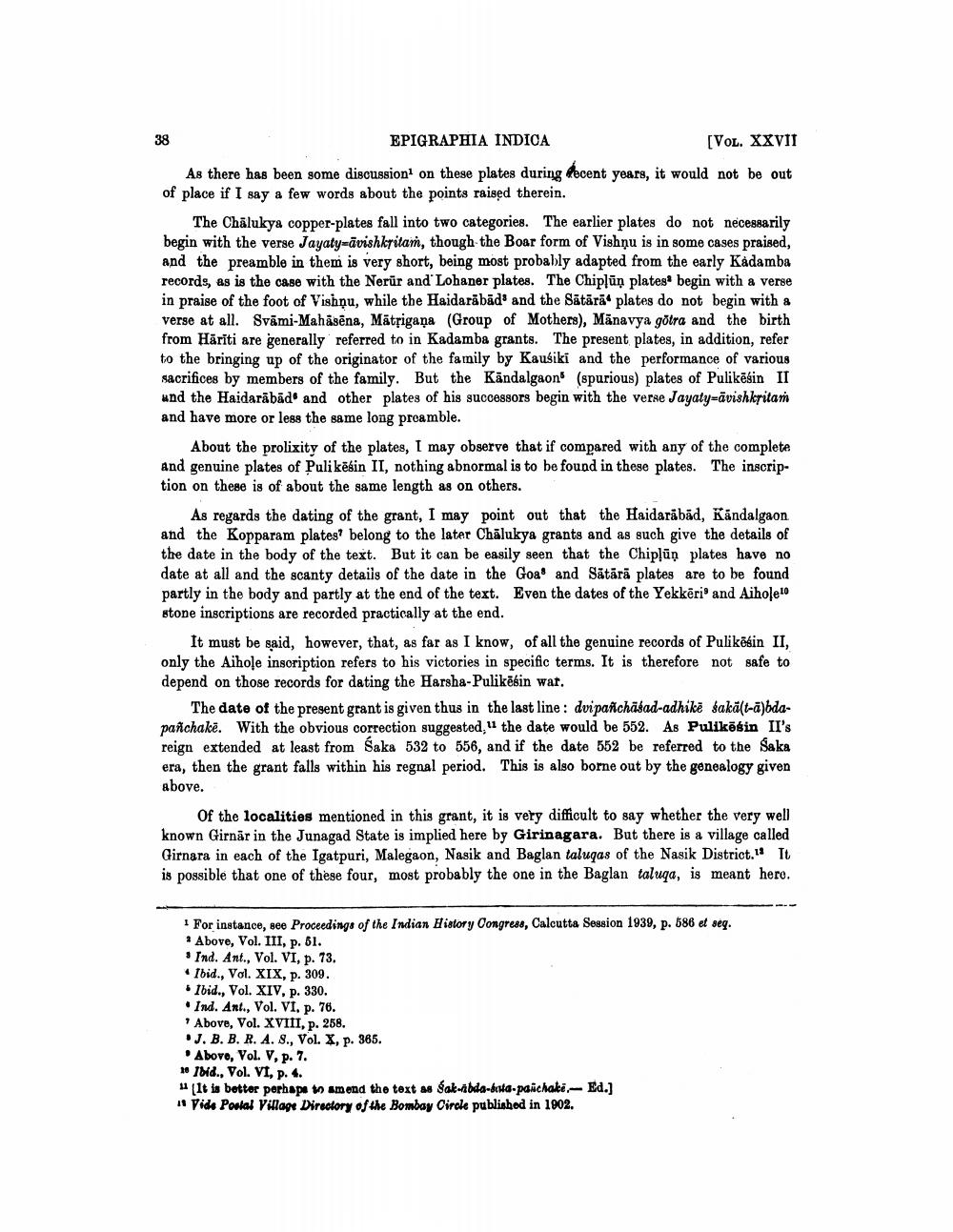________________
EPIGRAPHIA INDICA
[VOL. XXVII
As there has been some discussion on these plates during Recent years, it would not be out of place if I say a few words about the points raised therein.
The Chalukya copper-plates fall into two categories. The earlier plates do not necessarily begin with the verse Jayaty-ävishkritam, though the Boar form of Vishnu is in some cases praised, and the preamble in them is very short, being most probably adapted from the early Kadamba records, as is the case with the Nerür and Lohaner plates. The Chipļūņ plates begin with a verse in praise of the foot of Vishnu, while the Haidarābād' and the Sātārā plates do not begin with a verse at all. Svāmi-Mahäsēna, Mätrigana (Group of Mothers), Mänavya götra and the birth from Hārīti are generally referred to in Kadamba grants. The present plates, in addition, refer to the bringing up of the originator of the family by Kausiki and the performance of various sacrifices by members of the family. But the Kāndalgaon (spurious) plates of Pulikēsin II und the Haidarābāde and other plates of his successors begin with the verre Jayaly-ävishkritan and have more or less the same long preamble.
About the prolixity of the plates, I may observe that if compared with any of the complete And genuine plates of Pulikēsin II, nothing abnormal is to be found in these plates. The inscription on these is of about the same length as on others.
As regards the dating of the grant, I may point out that the Haidarābād, Kāndalgaon and the Kopparam plates belong to the later Chalukya grants and as such give the details of the date in the body of the text. But it can be easily seen that the Chipļūņ plates have no date at all and the scanty details of the date in the Goa and Sātārā plates are to be found partly in the body and partly at the end of the text. Even the dates of the Yekkeri and Aiholeto stone inscriptions are recorded practically at the end.
It must be said, however, that, as far as I know, of all the genuine records of Pulikēsin II, only the Aihole insoription refers to his victories in specific terms. It is therefore not safe to depend on those records for dating the Harsha-Pulikēsin war.
The date of the present grant is given thus in the last line: dvipanchāšad-adhikë sakālt-ā) bdapanchake. With the obvious correction suggested, the date would be 552. As Pullkēsin II's reign extended at least from Saka 532 to 556, and if the date 552 be referred to the Saka era, then the grant falls within his regnal period. This is also borne out by the genealogy given above.
Of the localities mentioned in this grant, it is very difficult to say whether the very well known Girnar in the Junagad State is implied here by Girinagara. But there is a village called Girnara in each of the Igatpuri, Malegaon, Nasik and Baglan taluqas of the Nasik District. It is possible that one of these four, most probably the one in the Baglan taluqa, is meant hero.
For instance, see Proceedings of the Indian History Congress, Calcutta Session 1939, p. 686 et seq. * Above, Vol. III, p. 61.
Ind. Ant., Vol. VI, p. 73. Ibid., Vol. XIX, p. 309.
Ibid., Vol. XIV, p. 330. • Ind. Ant., Vol. VI. p. 76. * Above, Vol. XVIII, p. 258.
J. B. B. R. A. 8., Vol. X, p. 365.
Above, Vol. V, p. 7. * Id., Vol. VI, p. 4. " (It is bottor porhaps to amend the text as Gak-abda-beta-paichaki-Ed.] I Vida Poslal Village Directory of the Bombay Circle published in 1902.




